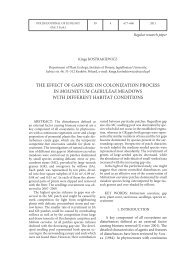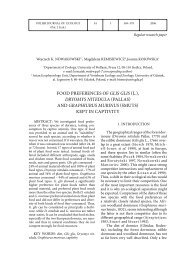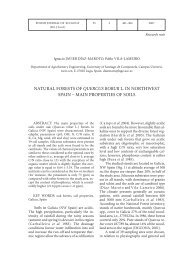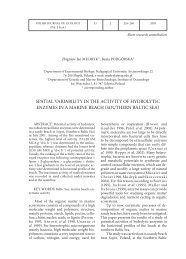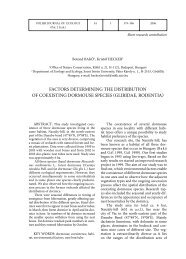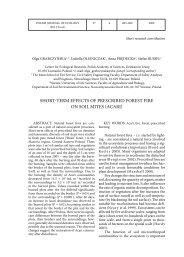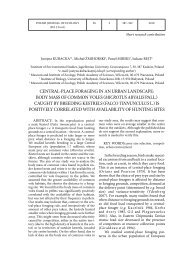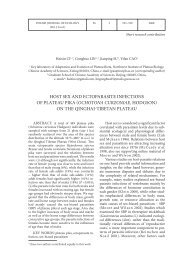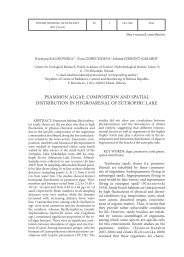Article - Polish Journal of Ecology
Article - Polish Journal of Ecology
Article - Polish Journal of Ecology
Create successful ePaper yourself
Turn your PDF publications into a flip-book with our unique Google optimized e-Paper software.
POLISH JOURNAL OF ECOLOGY<br />
(Pol. J. Ecol.)<br />
58 4 759–768 2010<br />
Regular research paper<br />
Maria OLESZCZUK 1 *, Malwina ULIKOWSKA 2 , Krzyszt<strong>of</strong> KUJAWA 1<br />
1<br />
Institute for Agricultural and Forest Environment, <strong>Polish</strong> Academy <strong>of</strong> Sciences, Field Station,<br />
Szkolna 4, 64–000 Turew, Poland, *e-mail: oleszczukm@vp.pl (corresponding author)<br />
2<br />
Rąbiń, Gajowa 1/2, 64–010 Krzywiń<br />
EFFECT OF DISTANCE FROM FOREST EDGE<br />
ON THE DISTRIBUTION AND DIVERSITY OF SPIDER WEBS<br />
IN ADJACENT MAIZE FIELD<br />
ABSTRACT: The study was carried out on<br />
lowland agricultural lands in western Poland between<br />
July and August 2007. The influence <strong>of</strong> the<br />
proximity <strong>of</strong> forested areas on the occurrence <strong>of</strong><br />
foliage-dwelling spiders was defined by measuring<br />
the abundance <strong>of</strong> spider webs on five transects<br />
situated at distances <strong>of</strong> 0, 20, 40, 60 and 80 metres<br />
from the forest edge. Generally, the greatest diversity<br />
and the highest total density were observed<br />
close to the forest edge, but an opposite relation<br />
was found for orb webs, built by spiders from the<br />
families Araneidae and Tetragnathidae, whose<br />
abundance was the lowest in close proximity to<br />
the forest. At a distance <strong>of</strong> 80 metres from the forest<br />
a slight increase in total abundance <strong>of</strong> webs<br />
was recorded, no doubt due to the presence <strong>of</strong><br />
weeds, in which were recorded numerous occurrences<br />
<strong>of</strong> sheet and irregular webs. On all the transects<br />
studied, orb webs predominated on maize<br />
shoots, whereas only three-dimensional sheet and<br />
irregular webs occurred on weeds. Included in<br />
this discussion are some <strong>of</strong> the potential effects <strong>of</strong><br />
the proximity <strong>of</strong> forest areas on foliage-dwelling<br />
spider populations in maize fields and on the possibilities<br />
for spiders limiting this crop’s pests.<br />
KEY WORDS: abundance <strong>of</strong> spiders, agricultural<br />
landscape structure, maize, cultivated<br />
fields, ecotonal zone<br />
1. INTRODUCTION<br />
For the last two decades much attention<br />
has been paid to the issue <strong>of</strong> biodiversity. One<br />
<strong>of</strong> the reasons for the increased interest in this<br />
topic is the search for some benefits for humans<br />
in connection with ecosystem services.<br />
It is commonly accepted that high species<br />
diversity contributes to the effectiveness <strong>of</strong><br />
biocenotic regulation in an ecosystem, which<br />
among other things may serve as a mechanism<br />
for limiting the numbers <strong>of</strong> some pest<br />
species on arable lands. Many studies have<br />
shown that the general level <strong>of</strong> biodiversity<br />
in farmland greatly depends on the structure<br />
<strong>of</strong> the landscape, mainly the presence<br />
<strong>of</strong> non-farmed elements fulfilling the role <strong>of</strong><br />
substitute habitats for many other species, including<br />
predators and parasites. Due to the<br />
presence <strong>of</strong> these habitats, species diversity<br />
in arable fields is much higher than on more<br />
uniform landscapes, where non-farmed habitats<br />
are very sparse. The mosaic-like structure<br />
<strong>of</strong> most farmland provides favourable<br />
conditions for many species <strong>of</strong> predatory or<br />
parasitic species, which can effectively reduce<br />
the populations <strong>of</strong> some pest species (Karg<br />
and Ryszkowski 1996, Karg 1999, 2004,<br />
Kajak 1990, 1998, Kajak and Oleszczuk<br />
journal 24b.indb 759 2011-01-14 21:37:24
760<br />
Maria Oleszczuk et al.<br />
2004, Thomas et al. 1991, Sunderland<br />
and Samu 2000, S chmidt et al. 2003, 2004,<br />
Thies et al. 2005, Flückiger and S chmidt<br />
2006). In consequence, recent studies on biodiversity<br />
have dealt with functional aspects,<br />
taking into account the role <strong>of</strong> a given species<br />
in the biocenosis, its trophic relations with<br />
other species and how these relations depend<br />
on habitat and landscape structure (Jeanneret<br />
et al. 2003, Birkh<strong>of</strong>er et al. 2007,<br />
Har wood and Obr ycki 2007, Öberg et al.<br />
2007, 2008, S chmidt et al. 2008, Richardson<br />
and Hanks 2009).<br />
One <strong>of</strong> the group <strong>of</strong> invertebrates that is<br />
<strong>of</strong>ten regarded as playing an important role<br />
in controlling the abundance <strong>of</strong> pest species<br />
in crop fields are spiders (Nyffeler 1982,<br />
1999, Rypstra 1995, Marc et al. 1999, Sunderland<br />
1999, Symondson et al. 2002,<br />
Maloney et al. 2003). Spiders catch their<br />
prey in two ways: by means <strong>of</strong> a web or by<br />
active hunting. Spider webs are very diverse<br />
in construction and size. The features <strong>of</strong> webs<br />
are strictly related to the taxonomy <strong>of</strong> spiders<br />
(Roberts 1995):<br />
• Linyphiidae build sheet-like webs<br />
without a retreat and the spider hangs<br />
beneath the web. The spider inserts<br />
a scaffolding <strong>of</strong> threads above the<br />
sheet<br />
• Araneidae and Tetragnathidae – spin<br />
orb webs, mostly almost vertical.<br />
These have developed as an efficient<br />
means <strong>of</strong> capturing flying insects.<br />
Their structure provides a unique<br />
combination <strong>of</strong> large capture area<br />
with close almost invisibility, making<br />
detection and avoidance difficult, especially<br />
at night.<br />
• Theridiidae – spin a tangled threedimensional<br />
web.<br />
The type <strong>of</strong> web construction is an evolutionarily<br />
adaptation towards the most effective<br />
way <strong>of</strong> catching a given set <strong>of</strong> insect<br />
species with given habitat preferences and<br />
type <strong>of</strong> flight (Nyffeler 1982, 1999, Sunderland<br />
et al. 1986, Har wood and Obr y-<br />
cki 2007, Ludy 2007). In consequence, the<br />
impact <strong>of</strong> spiders on a prey species depends<br />
on spider density and the web types present<br />
in a given habitat.<br />
The aim <strong>of</strong> our study was to determine<br />
the effect <strong>of</strong> the proximity <strong>of</strong> forest areas<br />
adjacent to fields planted with maize on the<br />
abundance <strong>of</strong> spider webs, the composition <strong>of</strong><br />
web construction types and the final effect on<br />
the diversity <strong>of</strong> prey species.<br />
2. STUDY AREA AND METHODS<br />
The study was carried out near the village<br />
<strong>of</strong> Turew, located in the central part <strong>of</strong><br />
the Dezydery Chłapowski Landscape Park<br />
(80 m a.s.l.), 30 kilometres south <strong>of</strong> Poznań<br />
(western Poland). The area is predominantly<br />
flat agricultural landscape, with gradients<br />
<strong>of</strong> less than 5%. The density <strong>of</strong> small rivers<br />
and canals amounts to 0.4 km km -2 and small<br />
bodies <strong>of</strong> water – 1.3 km -2 . Large, intensively<br />
farmed crop fields dominate the study area,<br />
but the landscape <strong>of</strong> the Park as a whole is<br />
characterized by a highly diversified structure,<br />
due to the presence <strong>of</strong> various nonfarmed<br />
habitats: woodland, copses, bodies <strong>of</strong><br />
water, wetlands, as well as a mosaic <strong>of</strong> smallsized<br />
crop fields. Crop fields and grasslands<br />
cover about 74% <strong>of</strong> the Park area, with woodland<br />
constituting about 15%. Woods are numerous,<br />
but highly fragmented. In most cases,<br />
small woods are composed <strong>of</strong> a mosaic <strong>of</strong><br />
small forest stands dominated by either Pinus<br />
sylvestris L. or Quercus robur L., sometimes<br />
with an admixture <strong>of</strong> Robinia pseudoacacia<br />
L., Picea abies L., Larix decidua Mill., Alnus<br />
glutinosa Gaertn., Betula pendula Roth and<br />
Fraxinus excelsior L. The undergrowth layer<br />
consists mainly <strong>of</strong> Padus serotina (Ehrh.)<br />
Borkh. The unique, mosaic structure <strong>of</strong> the<br />
farmland, rich in diverse non-farmed habitats,<br />
creates a favourable habitat for speciesrich<br />
communities <strong>of</strong> different organisms<br />
(Ryszkowski and Karg 1997).<br />
In the studied field, apart from maize<br />
plants, the following weeds were present:<br />
Echinochloa crus-galli (L.) P. Beauv., Chenopodium<br />
album L., Elymus (Agropyron) repens<br />
(L.) Gould, Stellaria media (L.) Vill. and Poa<br />
annua L. The two first mentioned plant species<br />
were the most numerous.<br />
The abundance <strong>of</strong> spider webs was determined<br />
twice: the first counting was performed<br />
from 18 th to 20 th <strong>of</strong> July and the second<br />
one – from 6 th to 9 th <strong>of</strong> August. The webs were<br />
counted on five transects <strong>of</strong> a maize field that<br />
were parallel to each other and to the edge <strong>of</strong><br />
a forest adjacent to this field. The tree stand at<br />
journal 24b.indb 760 2011-01-14 21:37:24
Effect <strong>of</strong> forest on crop field spider community 761<br />
Fig. 1. Scheme <strong>of</strong> sampling plots distribution.<br />
Fig. 2. Scheme <strong>of</strong> sampling plot. Grey color indicates the area where webs were counted.<br />
the edge <strong>of</strong> this forest consisted <strong>of</strong> ca 60-year<br />
old Robinia pseudoacacia with common elder<br />
and young robinia in the undergrowth layer.<br />
The distance between each <strong>of</strong> the transects<br />
amounted to 20 metres. Each transect consisted<br />
<strong>of</strong> 10 three metre long sampling plots<br />
(sections) distributed evenly, every 10 meters.<br />
The first transect was located in the row <strong>of</strong><br />
maize planted right at the forest edge and the<br />
others were located at distances <strong>of</strong> 20, 40, 60<br />
and 80 metres from the forest (Fig. 1).<br />
Each sampling plot consisted <strong>of</strong> a single<br />
row <strong>of</strong> maize (with stems and foliage up to 1.5<br />
metres in height) as well as a 0.7 metre wide<br />
strip <strong>of</strong> ground (with thinly growing weeds)<br />
between the two neighbouring rows <strong>of</strong> maize<br />
(Fig. 2).<br />
Spider webs were counted after spraying<br />
with water the whole <strong>of</strong> a sampling plot. This<br />
measure made webs visible even when they<br />
were <strong>of</strong> a very small size. The type <strong>of</strong> construction<br />
and location <strong>of</strong> the webs were used<br />
as features enabling their classification to one<br />
<strong>of</strong> the four spider families: Linyphiidae (sheet<br />
webs), Theridiidae (irregular webs) or Araneidae<br />
and Tetragnathidae (orb webs) (Roberts<br />
1995).<br />
3. RESULTS<br />
The abundance <strong>of</strong> spider webs was negatively<br />
correlated with distance from the forest<br />
(Fig. 3). The gamma correlation coefficient<br />
amounted to −0.67 (P< 0.001), but this<br />
journal 24b.indb 761 2011-01-14 21:37:24
762<br />
Maria Oleszczuk et al.<br />
Fig. 3. Total density <strong>of</strong> spider webs (arithmetical means and SD) in relation to distance from the forest<br />
(see Fig.1). Solid line illustrates relationship between distance (x) and density (y): y=8.87−1.09log(x)<br />
Table 1. Statistical significance <strong>of</strong> differences in total spider webs density between studied distances<br />
from the forest ( see Fig.1).<br />
Distance 20 40 60 80<br />
0 ns ** *** **<br />
20 ns ** ns<br />
40 ns ns<br />
60 ns<br />
**–P
Effect <strong>of</strong> forest on crop field spider community 763<br />
4. DISCUSSION<br />
4.1. Web abundance and the contribution<br />
<strong>of</strong> particular spider families<br />
The diversity and abundance <strong>of</strong> web-spinning<br />
spiders occurring in crop fields depends<br />
considerably on the type <strong>of</strong> crop, and thus on<br />
the structure (construction) <strong>of</strong> the cultivated<br />
plant species and the accompanying weeds.<br />
Web abundance in the maize field in our study<br />
(taking into account only those transects separated<br />
by a distance <strong>of</strong> over 20 metres from<br />
the forest in order to eliminate the influence<br />
<strong>of</strong> the surrounding environment) amounted<br />
to 5 webs per m 2 . Assuming that web abundance<br />
is closely related to total abundance <strong>of</strong><br />
web-spinning spiders, the figures recorded<br />
are similar to those obtained in the study carried<br />
out in Germany, where spider abundance<br />
in the maize field studied amounted to 5.9<br />
ind. m -2 and the majority <strong>of</strong> these were webspinning<br />
spiders (Ludy and L ang 2004).<br />
Nyffeler and Benz (1979) found a markedly<br />
lower abundance <strong>of</strong> foliage-dwelling spiders<br />
in similar crop: 0.1 ind. m -2 . In a soybean<br />
field over a similar period as that <strong>of</strong> the present<br />
study, i.e. in the middle <strong>of</strong> the vegetative<br />
season, spider web abundance amounted to 2<br />
webs per m 2 (Balfour and Rypstra 1998).<br />
In the same area where our study was conducted,<br />
foliage-dwelling spider abundance<br />
was previously studied in arable fields in July<br />
and August, and it was found that the majority<br />
<strong>of</strong> these were web-spinning species. The<br />
recorded abundance <strong>of</strong> web-spinning spiders<br />
ranged between 0.6 and 14.0, in alfalfa – 3.6<br />
and 3.0, in potato – 0.7 and 14.1 and in rye<br />
– 0.6 and 1.0 per m 2 (Łuczak 1975). The<br />
higher spider abundance (with exception <strong>of</strong><br />
potato) observed in the maize crop is probably<br />
most commonly caused by the lack <strong>of</strong><br />
other cereal crops in the fields in the period<br />
<strong>of</strong> the studies (July/August), because this is<br />
after the harvest time for these plants. Many<br />
<strong>of</strong> the spiders usually occurring on cereals<br />
may move to adjacent fields with crop plants,<br />
for example maize yet to be harvested, and for<br />
this reason spider abundance in these crops<br />
can be relatively high during this period.<br />
Fig 4. Density <strong>of</strong> Linyphiidae (A) and Theridiidae (B) spider webs (arithmetical means and 95% confidence<br />
level) in relation to distance from the forest (see Fig.1).<br />
Fig. 5. Relationship between web density (per m 2 ) <strong>of</strong> spiders from families Linyphiidae and Theridiidae.<br />
journal 24b.indb 763 2011-01-14 21:37:24
764<br />
Maria Oleszczuk et al.<br />
Fig 6. Combined density <strong>of</strong> Araneidae and Tetragnathidae spider webs (arithmetical means and 95%<br />
confidence level) in relation to distance from the forest (see Fig.1).<br />
Fig. 7. Density <strong>of</strong> spider’s web in relation to distance from forest (Fig.1) and place <strong>of</strong> their building.<br />
Orb webs, characteristic for Araneidae<br />
and Tetragnathidae, prevailed among the spider<br />
webs recorded in our study. Among the<br />
various types <strong>of</strong> webs recorded in maize fields<br />
in Switzerland (Nyffeler 1982) and the USA<br />
(Uetz et al. 1999), the highest contribution<br />
was also that <strong>of</strong> orb weaving spiders. Similar<br />
results were obtained in research carried out<br />
in a maize crop in an area located close to<br />
Turew village in an earlier period, when again<br />
spiders from the Araneidae and Tetragnathidae<br />
families were the most abundant. Three<br />
dominant foliage-dwelling species were recorded:<br />
Mangora acalypha Walck., Aculepeira<br />
ceropegia Walck. and Araniella cucurbitina<br />
Cl. The first two species mentioned are photophilous<br />
spiders (Nentwig et al. 2003), preferring<br />
areas with low plant cover and usually<br />
occurring in meadows but also in cultivated<br />
fields (Barthel and Platcher 1995, 1996;<br />
Wolak 2002, 2004, Ludy and L ang 2004,<br />
2006). Łuczak (1975) observed that in the<br />
fields located in the mosaic <strong>of</strong> habitats around<br />
the village <strong>of</strong> Turew, the species M. acalypha<br />
was 2.4 times more numerous than in<br />
landscape lacking <strong>of</strong> shelterbelts and forests.<br />
Thus, it seems that the presence in the agricultural<br />
landscape <strong>of</strong> semi natural habitats,<br />
such as belts <strong>of</strong> trees or shrubs, favours a high<br />
number <strong>of</strong> some orb web spider species.<br />
The significance <strong>of</strong> the type <strong>of</strong> vegetation<br />
adjoining crop fields has been confirmed by<br />
research carried out in Germany (Bavaria). In<br />
maize fields surrounded by margins covered<br />
in nettles, the species from the families spinning<br />
space webs (Theridiidae and Linyphiidae)<br />
predominated among the spiders spinning<br />
webs on plants. The spiders represented<br />
in lesser numbers were those catching their<br />
prey in orb webs – Tetragnathidae and Araneidae.<br />
However, the contribution <strong>of</strong> the<br />
family Araneidae was considerably higher on<br />
field margins (almost 20%, compared to 10%<br />
in maize fields), this being, in the authors’<br />
opinion, connected with the dense vegetation<br />
cover (Ludy and L ang 2004). In Hungary’s<br />
maize crops on the other hand, the predominant<br />
species among foliage-dwelling spiders<br />
was Phylloneta impressa L. K. – one <strong>of</strong> the<br />
most common species in Europe, spinning<br />
journal 24b.indb 764 2011-01-14 21:37:24
Effect <strong>of</strong> forest on crop field spider community 765<br />
irregular, three-dimensional webs. This is<br />
a photophilous species, which in Poland can<br />
be found in cereal fields, their abundance being<br />
higher on plants with greater branching<br />
<strong>of</strong> shoots, such as potatoes. The above mentioned<br />
studies as well as our own results reveal<br />
that maize fields are inhabited by fairly variable<br />
assemblages <strong>of</strong> spider species, in which<br />
different families may dominate, leading<br />
to different web types predominating from<br />
one site to another. The results <strong>of</strong> the present<br />
study also suggest that the type <strong>of</strong> vegetation<br />
covering the margins <strong>of</strong> these fields has<br />
an important influence on the composition <strong>of</strong><br />
the spider species occurring.<br />
It is worth adding that although this study<br />
was conducted over just a short period <strong>of</strong><br />
time, the results concerning the contribution<br />
<strong>of</strong> particular families can be treated as representative,<br />
because the peak figures for the<br />
spider families discussed occur in the same<br />
periods (Ludy and L ang 2004).<br />
4.2. The influence <strong>of</strong> distance from<br />
a forest on spider webs distribution<br />
The present study demonstrates a distinct<br />
connection between spider web types and<br />
abundance in maize fields and the proximity<br />
<strong>of</strong> forest. As the distance from the forest<br />
increased, total web abundance decreased,<br />
and among the three spider families studied,<br />
only spiders building orb webs demonstrated<br />
an opposite tendency, i.e. abundance <strong>of</strong> webs<br />
was the lowest right next to the forest edge<br />
(an average <strong>of</strong> less than one web per m 2 ), but<br />
already from a distance <strong>of</strong> 20 metres it was as<br />
high as at any greater distance. This is probably<br />
caused by the preference <strong>of</strong> that family’s<br />
species to well insulated biotopes. The only<br />
exception is Araniella cucurbitina, which is<br />
commonly observed in forests, so it is quite<br />
likely to occur in the ecotonal zone between<br />
forest and crop field. The webs distribution<br />
pattern in the Linyphiidae and Theridiidae<br />
families confirms the thesis that spiders<br />
do not spin webs on random sites, preferring<br />
areas where the abundance and diversity<br />
<strong>of</strong> potential prey species is high (Har wood<br />
and Obr ycki 2007). Ecotonal zones abound<br />
in diverse species <strong>of</strong> those insects that constitute<br />
the staple diet <strong>of</strong> spiders (Karg and<br />
Ryszkowski 1996, Karg 2004), and this<br />
partially explains the highest web abundance<br />
at the border <strong>of</strong> maize fields adjoining a forest<br />
and the reduced abundance inside the field,<br />
where insect numbers are generally lower<br />
(Karg 2007).<br />
The data collected on the transect situated<br />
at a distance <strong>of</strong> 80 meters from the forest<br />
indicate that local differentiation <strong>of</strong> vegetation<br />
cover also has an important influence on<br />
web abundance. On this transect, web abundance<br />
was higher than expected according to<br />
the observed relationship between total web<br />
abundance and distance from the forest. This<br />
inconsistency is due to the slightly higher<br />
than expected abundance <strong>of</strong> the sheet webs<br />
<strong>of</strong> Linyphiidae, this pattern being illustrated<br />
by the curve in Fig. 3. This can be explained<br />
by the occurrence <strong>of</strong> numerous weeds on<br />
some <strong>of</strong> the sections <strong>of</strong> this transect, covering<br />
a considerable part <strong>of</strong> the area and thus making<br />
suitable conditions for sheet webs. This<br />
observation also indicates a mechanism by<br />
which web abundance increases nearer forest.<br />
A belt several metres in width adjoining<br />
the forest is usually characterized by a greater<br />
amount <strong>of</strong> weeds, as was indeed observed in<br />
the study area. As a result, most <strong>of</strong> the sheet<br />
webs <strong>of</strong> linyphiid spiders were found just adjacent<br />
to the forest. So, for the species from<br />
this family (or at least some <strong>of</strong> them), proximity<br />
<strong>of</strong> a forest or the presence <strong>of</strong> the habitat<br />
itself is probably not as important as the fact<br />
that in the belt <strong>of</strong> the field adjoining the forest<br />
the abundance <strong>of</strong> weeds is usually higher than<br />
at any greater distance from the forest. It can<br />
therefore be concluded that for spider species<br />
from this family observed in the maize field,<br />
the limiting factor is a shortage <strong>of</strong> weeds as<br />
elements <strong>of</strong> suitable scaffolding.<br />
However, among the spider species<br />
studied, one group can be distinguished,<br />
for which distance from the forest is probably<br />
a key factor. These are species building<br />
their webs next to the ground – in hollows or<br />
near the surface. These are tiny spiders from<br />
the subfamily Erigonine (Linyphiidae). The<br />
abundance <strong>of</strong> these webs was the highest next<br />
to the forest, whereas in the transect located<br />
the farthest from the forest – despite the large<br />
numbers <strong>of</strong> weeds growing – web abundance<br />
was not different from that at a distances <strong>of</strong><br />
60 or 40 metres from the forest.<br />
journal 24b.indb 765 2011-01-14 21:37:25
766<br />
Maria Oleszczuk et al.<br />
4.3. The influence <strong>of</strong> forest proximity<br />
on the potential impact <strong>of</strong> spiders on<br />
insect abundance in cultivated fields<br />
Among foliage-dwelling spiders, each<br />
family and in some cases particular species<br />
build characteristic types <strong>of</strong> web. Moreover,<br />
even within the same family, webs may differ<br />
in vertical distribution. Particular web types<br />
are adapted to catch defined types <strong>of</strong> prey, for<br />
example orb webs mainly filter from the air<br />
flying insects such as Diptera and Homoptera<br />
(Nyffeler 1999, Ludy 2007). These two orders<br />
<strong>of</strong> insect include among others important<br />
maize pest species (Oscinella frit L., Elachiptera<br />
cornuta Fall., Delia platura Mig. and<br />
Aphidae), which can be successfully eliminated<br />
by being caught in orb webs and falling<br />
prey to spiders. Some spider species hunt<br />
much more diverse prey in terms <strong>of</strong> both their<br />
taxonomical and ecological features. For instance,<br />
the spider species Phylloneta impressa<br />
(Theridiidae) catches Aphidae and Diptera in<br />
its webs (Nyffeler 1982, Pekár 2000), but<br />
at the same time these webs also catch insects<br />
that jump and run among plants (Nyffeler<br />
1982). Insects from the Heteroptera order are<br />
<strong>of</strong>ten found in the irregular webs <strong>of</strong> theridiid<br />
spiders too (Árpás et al. 2005). So it may be<br />
assumed that more taxonomically diverse the<br />
spider commmunity caused the greater web<br />
diversity and this increases the possibilities<br />
for spiders contributing to the effective control<br />
<strong>of</strong> insect pest numbers. Since the diversity<br />
and abundance <strong>of</strong> webs are the highest<br />
just adjacent to a forest adjoining a field, the<br />
influence <strong>of</strong> the presence <strong>of</strong> forest on the potential<br />
reduction <strong>of</strong> insect numbers by spiders<br />
may be considerable.<br />
5. CONCLUSIONS<br />
1. Proximity <strong>of</strong> a forest positively affects<br />
spider web abundance and diversity<br />
in an adjoining crop field, which <strong>of</strong>fers<br />
possibilities for natural control<br />
<strong>of</strong> pest numbers by foliage-dwelling<br />
spiders.<br />
2. The highest predation potential <strong>of</strong><br />
spiders is localized in the crop fieldforest<br />
ecotonal zone due to the high<br />
abundance <strong>of</strong> webs and their diversity.<br />
3. The presence <strong>of</strong> weeds in a crop favours<br />
a high abundance <strong>of</strong> three-dimensional<br />
spider webs.<br />
4. The predominance <strong>of</strong> orb web numbers<br />
on maize shoots favours the<br />
capture <strong>of</strong> this crop’s pests, because<br />
a considerable proportion <strong>of</strong> these<br />
are precisely the tiny insects filtered<br />
by this type <strong>of</strong> web.<br />
ACKNOWLEDGMENTS: We acknowledge<br />
the help <strong>of</strong> Richard Bialy who corrected our<br />
English.<br />
6. REFERENCES<br />
Árpás K., Tóth F., Kiss J. 2005 – Foliagedwelling<br />
arthropods in Bt-transgenic and isogenic<br />
maize: a comparison through spider web<br />
analysis – Acta Phytopathol. Entomol. Hung.<br />
40: 347–353.<br />
Balfour R.A., Rypstra A.L. 1998 – The influence<br />
<strong>of</strong> habitat structure on spider density<br />
in a no-till soybean agroecosystem – J. Arachnol.<br />
26: 221–226.<br />
Barthel J., Platcher H. 1995 – Distribution <strong>of</strong><br />
foliage-dwelling spiders in uncultivated areas<br />
<strong>of</strong> agricultural landscapes (Southern Bavaria,<br />
Germany) (Arachnida, Araneae) (In: Proc.<br />
15 th Europ. Coll. Arachnol., Ed: V. Ružička)<br />
– Institute <strong>of</strong> Entomology, Česke Budejowice,<br />
pp: 11–21.<br />
Barthel J., Platcher H. 1996 – Significance<br />
<strong>of</strong> field margins for foliage-dwelling spiders<br />
(Arachnida, Araneae) in an agricultural landscape<br />
<strong>of</strong> Germany – Revue Suisse de Zoologie.<br />
Hors série 2: 45–59.<br />
Birkh<strong>of</strong>er K., Scheu S., Wise D. 2007 –<br />
Small-scale spatial pattern <strong>of</strong> web-building<br />
spiders (Araneae) in alfalfa: relationship to<br />
disturbance from cutting, prey availability and<br />
intraguild interactions – Environ. Entomol.<br />
36: 801–810.<br />
Flückiger R., Schmidt M.H. 2006 – Contribution<br />
<strong>of</strong> sown wildflower areas to cereal<br />
aphid control: from local to landscape scale –<br />
IOBC/WPRS Bulletin 29: 41–44.<br />
Har wood J.D., Obr ycki J.J. 2007 – Web-site<br />
selection strategies <strong>of</strong> linyphiid spiders in alfalfa:<br />
implications for biological control – Bio-<br />
Control, 52: 451–469.<br />
Jeanneret Ph., Schüpbach B., Luka H.<br />
2003 – Quantifying the impact <strong>of</strong> landscape<br />
journal 24b.indb 766 2011-01-14 21:37:25
Effect <strong>of</strong> forest on crop field spider community 767<br />
and habitat features on biodiversity in cultivated<br />
landscapes – Agric. Ecosyst. Environ.<br />
98: 311–320.<br />
Kajak A. 1990 – Spatial pattern <strong>of</strong> the intensity<br />
<strong>of</strong> area searching by predators – Acta Zool.<br />
Fenn. 190: 199 – 204.<br />
Kajak A. 1998 – Nieleśne wyspy środowiskowe<br />
a bezkręgowce pól uprawnych [Non-forest<br />
habitat islands and invertebrates <strong>of</strong> crop fields]<br />
(In: Ekologia wysp leśnych [<strong>Ecology</strong> <strong>of</strong> Forest<br />
Islands ] Ed: J. Banaszak) – Bydgoszcz University<br />
Press, Bydgoszcz, 267–278 ( in <strong>Polish</strong> with<br />
English summary).<br />
Kajak A., Oleszczuk M. 2004 – Effect <strong>of</strong><br />
Shelterbelts on adjoining cultivated Fields:<br />
patrolling intensity <strong>of</strong> carabid beetles (Carabidae)<br />
and spiders (Araneae) – Pol. J. Ecol. 52 :<br />
155–172.<br />
Karg J. 1999 – Rola zadrzewień śródpolnych<br />
w podnoszeniu bogactwa zespołów owadów<br />
w krajobrazie rolniczym [The role <strong>of</strong> midfield<br />
shelterbelts in the increasing <strong>of</strong> insect communities<br />
diversity in agricultural landscapes] (In:<br />
Ochrona owadów w Polsce u progu integracji<br />
z Unią Europejską [Conservation <strong>of</strong> insects<br />
in Poland at the threshold <strong>of</strong> integration into<br />
the European Union], Scientific Conference,<br />
23–24 September 1999, Kraków, pp: 27.<br />
Karg J. 2004 – Importance <strong>of</strong> midfield shelterbelts<br />
for over-wintering entom<strong>of</strong>auna (Turew<br />
area, West Poland) – Pol. J. Ecol. 52: 421–431.<br />
Karg J. 2007 – Urozmaicony krajobraz rolniczy<br />
okolic Turwi: ekologiczne podstawy funkcjonowania<br />
i zasady kształtowania [Mosaic agricultural<br />
landscape <strong>of</strong> the vicinity <strong>of</strong> Turew:<br />
ecological basis <strong>of</strong> landscape functioning and<br />
principles <strong>of</strong> landscape management] (In:<br />
Ochrona Środowiska Rolniczego w świetle<br />
programów rolno-środowiskowych Unii Europejskiej<br />
[Protection <strong>of</strong> agricultural environment<br />
in the view <strong>of</strong> agri-environmental<br />
measures] Eds: S. Bałazy, S. Gmiąt) – Brzesko<br />
– Poznań – Turew, pp: 40–73.<br />
Karg J., Ryszkowski J. 1996 – Wpływ struktury<br />
krajobrazu rolniczego na bioróżnorodność<br />
i procesy regulacji biocenotycznej [Influence<br />
<strong>of</strong> agricultural landscape structure on biodiversity<br />
and biocenotic regulation processes]<br />
(In: Ekologiczne procesy na obszarach intensywnego<br />
rolnictwa [Ecological processes on<br />
the intensive agriculture areas] Eds: L. Ryszkowski,<br />
S. Bałazy) – ZBSR i L PAN, Poznań,<br />
pp: 21–31 (in <strong>Polish</strong>).<br />
Ludy C. 2007 – Prey selection <strong>of</strong> orb-web spiders<br />
(Araneidae) on field margins – Agric.<br />
Ecosyst. Environ. 119: 368–372.<br />
Ludy C., Lang A. 2004 – How to catch foliagedwelling<br />
spiders (Araneae) in maize fields and<br />
their margins: a comparison <strong>of</strong> two sampling<br />
methods – J. Appl. Entomol. 128: 501–509.<br />
Ludy C., Lang A. 2006 – A 3-year field-scale<br />
monitoring <strong>of</strong> foliage-dwelling spiders (Araneae)<br />
in transgenic Bt maize fields and adjacent<br />
field margins – Biol. Control, 38: 314–324.<br />
Łuczak J. 1975 – Spider communities <strong>of</strong> the<br />
crop-fields – Pol. Ecol. Stud. 1: 93–110.<br />
Maloney D., Drummond F. A., Alford R.<br />
2003 – Spider Predation in Agroecosystems:<br />
Can Spiders effectively Control Pest Populations?<br />
– The University <strong>of</strong> Main, MAFES<br />
Technical Bulletin 190, 32 pp.<br />
Marc P., Canard A., Ysnel F. 1999 – Spiders<br />
(Araneae) useful for pest limitation and<br />
bioindication – Agric. Ecosyst. Environ. 74:<br />
229–273.<br />
Nentwig W., Hanggi A., Kropf Ch., Blick<br />
T. 2003 – Central European spiders -determination<br />
key. Version 8.12.2003 – http://www.<br />
araneae.unibe.ch<br />
Nyffeler M. 1982 – Field studies on the ecological<br />
role <strong>of</strong> the spiders as insects predators in<br />
agroecosystems (abandoned grassland, meadows<br />
and cereal fields) – Ph.D thesis, Swiss Federal<br />
Institute <strong>of</strong> Technology, Zurich, 174 pp.<br />
Nyffeler M. 1999 – Prey selection <strong>of</strong> spiders in<br />
the field – J. Arachnol. 27: 317–324.<br />
Nyffeler M., Benz G. 1979 – Zur ökologischen<br />
Bedeutung der Spinnen der Vegetationsschicht<br />
von Getreide und Rapsfeldern bei<br />
Zürich (Schweiz) [Studies on the ecological<br />
importance <strong>of</strong> spider populations for the vegetation<br />
<strong>of</strong> cereal and rape fields] – Z. Angew.<br />
Entomol. 87: 348–376.<br />
Öberg S., Ekbom B., Bommarco R. 2007<br />
– Influence <strong>of</strong> habitat type and surrounding<br />
landscape on spider diversity in Swedish agroecosystems<br />
– Agric. Ecosyst. Environ. 122:<br />
211–219.<br />
Öberg S., Mayr S., Dauber J. 2008 – Landscape<br />
effect on recolonization patterns <strong>of</strong> spiders<br />
in arable fields – Agric. Ecosyst. Environ.<br />
123: 211–218.<br />
Pekár S. 2000 – Webs, diet, and fecundity <strong>of</strong><br />
Theridion impressum (Araneae: Theridiidae) –<br />
Eur. J. Entomol. 97: 47–50.<br />
journal 24b.indb 767 2011-01-14 21:37:25
768<br />
Maria Oleszczuk et al.<br />
Richardson M.L., Hanks L. 2009 – Partitioning<br />
<strong>of</strong> niches among four orb-weaving spiders<br />
in grassland habitat – Environ. Entomol.<br />
38: 651–656.<br />
Roberts M.J. 1995 – Spiders <strong>of</strong> Britain and<br />
Northern Europe – Collins Field Guide. Harper<br />
Collins Publishers, 383 pp.<br />
Rypstra A.L. 1995 – Spider predators reduce<br />
herbivory; both by direct consumption and by<br />
altering the foraging behavior <strong>of</strong> insect pests –<br />
Bull. Ecol. Soc. Am. 76: 383.<br />
Ryszkowski L., Karg J. 1997 – The influence<br />
<strong>of</strong> agricultural landscape diversity on biological<br />
diversity (In: Multifunctional land use,<br />
Eds:. Ü. Mander, H. Wiggiering, K. Helming)<br />
– Springer Berlin Heidelberg New York: pp:<br />
125–141.<br />
Schmidt M.H., Lauer A., Purtauf T.,<br />
Thies C., Schaefer M., Tscharntke T.<br />
2003 – Relative importance <strong>of</strong> predators and<br />
parasitoids for cereal aphid control – Proc. R.<br />
Soc. B 270: 1905–1909.<br />
Schmidt M.H., Thies C., Tscharntke T.<br />
2004 – The landscape context <strong>of</strong> arthropod<br />
biological control (In: Ecological Engineering<br />
for Pest Management: Advances in Habitat<br />
Manipulation for Arthropods, Eds: G.M. Gurr,<br />
S.D. Wratten, M.A. Altieri) – CSIRO, Collingwood<br />
VIC, pp. 55–63.<br />
Schmidt M.H., Thies C., Nentwig W.,<br />
Tscharntke T. 2008 – Contrasting responses<br />
<strong>of</strong> arable spiders to the landscape matrix at<br />
different spatial scales – J. Biogeogr. 35: 157–<br />
166.<br />
Sunderland K.D. 1999 – Mechanisms underlying<br />
the effects <strong>of</strong> spiders on pest populations<br />
– J. Arachnol. 27: 308–316.<br />
Sunderland K.D., Fraser A.M., Dixon<br />
A.F.G. 1986 – Distribution <strong>of</strong> linyphiid spiders<br />
in relation to capture <strong>of</strong> prey in cereal<br />
fields – Pedobiologia, 29: 367–375.<br />
Sunderland K.D., Samu F. 2000 – Effects<br />
<strong>of</strong> agricultural diversification on the abundance,<br />
distribution, and pest control potential<br />
<strong>of</strong> spiders: a review – Entomol. Exp. Appl. 95:<br />
1–13.<br />
Symondson W.O.C., Sunderland K.D.,<br />
Greenstone M.H. 2002 – Can generalist<br />
predators be effective biocontrol agents? –<br />
Annu. Rev. Entomol. 47: 561–594.<br />
Thies C., Roschewitz I., Tscharntke T.<br />
2005 – The landscape context <strong>of</strong> cereal aphidparasitoid<br />
interactions – Proc. R. Soc. B, 272:<br />
203–210.<br />
Thomas M., Wratten S., Sotherton N.<br />
1991 – Creation <strong>of</strong> „island” habitats in farmland<br />
to manipulate populations <strong>of</strong> beneficial<br />
arthropods: predator densities and emigration<br />
– J. Appl. Ecol. 28, 906–917.<br />
Uetz G.W., Halaj J., Cady A.B. 1999 –<br />
Guild structure <strong>of</strong> spiders in major crops – J.<br />
Arachnol. 27: 270–280.<br />
Wolak M. 2002 – The spider fauna <strong>of</strong> balks<br />
(In: European Arachnology 2000, Proc.<br />
19 th Europ. Coll. Arachnol., Eds: S. T<strong>of</strong>t, N.<br />
Scharff) – Århus University Press, Århus, pp.<br />
229–326.<br />
Wolak M. 2004 – The significance <strong>of</strong> unmanaged<br />
“island” habitats for epigeic spiders in<br />
a uniform agricultural landscape (In: European<br />
Arachnology 2002, Proc. 20 th Europ. Coll.<br />
Arachnol., Eds: F. Samu, Cs. Szinetar) – Plant<br />
Protection Institute and Berzsenyi College,<br />
Budapest, pp: 327–336.<br />
Received after revision February 2010<br />
journal 24b.indb 768 2011-01-14 21:37:25




